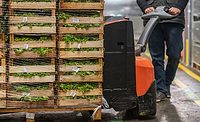Supply Chain Woes – What is At Stake, and What Will Change?
Unanticipated disruptions, complicated by lean manufacturing principles, can quickly create a critical supply situation.

Over the past two years, the pandemic has exposed new weaknesses and made visible the business risks posed by an unstable supply chain. These supply chain issues have continued to become more acute and are now front-page news.
Most people involved in food processing and other manufacturing operations will be familiar with sales and operations planning—i.e., S&OP. This process is used to produce future plans for product manufacturing and ensures that the need for purchasing and receiving raw materials matches the demand for those materials on the specific days they will be needed. This helps align the manufacturing schedule with the sales forecast, ensuring that products are available for delivery to customers on time.
For most manufacturers, this is an intricate process with many moving parts that requires accurate sales and demand forecasts. Most manufacturers will say that S&OP works well when sales and raw material supplies are stable and predictable. In the absence of predictability, however, the entire process can become disrupted, nothing is where it is supposed to be at the time it is needed, and the business grinds to a halt.
This is what we are seeing across all markets today. Large swings in demand for products and logistical delays are causing the types of shortages of materials and services that make planners’ jobs impossible. These shortages, in turn, cause price fluctuations that further exacerbate the problem, and the spiral continues.
In two Food Safety Insights articles earlier in 2021, we focused on supply chain issues and forecasted many of the issues that we are living through right now. In our December 1 Food Safety Magazine Leadership Panel Discussion focused on supply chains (available here), we discussed with Frank Yiannis of the FDA and Sean Leighton of Cargill the vulnerabilities of the supply chain that have been revealed by the pandemic, what is being done to relieve the short-term pressure, and what future changes can be expected.
One of the key issues discussed in those articles and in the panel discussion was the interconnectedness of supply chains and the difficulties that can be caused by unanticipated disruptions or unexpected swings in demand. These difficulties are further complicated by lean manufacturing principles that focus on cost control by holding a minimum of inventory (of both raw materials and finished products). While lean manufacturing is no doubt cost-efficient, it relies on extremely close coordination of supplies and deliveries. If the S&OP planning process described above is disrupted, lean processes leave little to no inventory flexibility to respond, and the situation quickly becomes critical.
This is one of the risks that has been exposed by the pandemic. It is also one of the reasons that lean manufacturing and “just-in-time” supply chain and inventory management is giving way to a principle of “just-in-case.” Just-in-time was an appropriate low-cost strategy for a period of stable, steady growth and stable supply chains. However, under the stress of the pandemic, it turned into a business risk for many companies that ran out of raw materials or other critical supplies (e.g., gloves, cleaning and sanitizing chemicals, packaging, etc.), which threatened their ability to operate. Their low levels of finished product inventory gave them little flexibility to continue supplying their customers while they solved their sourcing issues.
For some companies, this risk proved fatal to their businesses. One processor we spoke with—a bakery that supplies many of the larger grocery and big-box retailers in the U.S.—typically ran two shifts per day, five days per week in a typical year. Since early 2021, however, it has been running three shifts, seven days per week to meet demand. When I asked why the company was so busy, its general manager told me that the company’s flexible manufacturing capacity gave it the ability to respond when the market shifted, as the pandemic drove demand from restaurants to retail customers. The manager also told me, however, that a larger driver in his company’s shift in demand was the inability of its competitors to do the same. Without the flexibility to respond and keep up with orders, retail customers turned to the manager’s company to keep them supplied. Several of his competitors were forced out of business.
For those companies forced out of business, this is a tragic example of the level of risk involved. Many others have managed through the pandemic, but not without substantial damage to their businesses—damage which none of them are interested in seeing repeated in the future. As we reported earlier this year, many processors will be looking to establish new secondary and tertiary vendors for necessary supplies and have made plans to keep more backup stock on hand. This inventory strengthening and a more complex supply chain bring additional costs in terms of qualifying additional suppliers plus the commensurate inspection, testing, and auditing costs. Many processors, however, are coming to the conclusion that these costs are reasonable and the additional savings realized from lean supply chain management may not be worth the business continuity risks.
It is important to recognize that the recovery from the pandemic may be just as fraught with risk as was its onset. Supply chain disruptions are due to sudden shifts in demand, and these shifts will inevitably occur just as unpredictably when consumer demand re-emerges as they did when demand disappeared. For example, in early 2020, when businesses shuttered and fewer people were driving, demand for gasoline decreased substantially, causing prices to drop and inventories to increase. This also caused a reduction in demand for ethanol, which forced a number of ethanol plants to cease production. In turn, many food processors saw supplies of alcohol-based sanitizers start to disappear. What was available sold for very high prices.
Now, as more people resume driving, demand for gasoline is increasing and fuel prices are climbing higher. Greater demand for gasoline is driving greater demand for ethanol and, until the plants are again running at full capacity, we will continue to see shortages of ethanol, and prices will remain high. In fact, ethanol prices are close to three times higher than they were at this time in 2020, and the price of corn (which is used to make ethanol) is higher than it has been in almost ten years. Any food processor that uses corn or ethanol, including alcohol-based sanitizers, can expect much higher prices and constraints on supply.
Many processors told us that during the height of the pandemic they were seeing significant shortages in sanitizer chemicals, including alcohol-based products. They had to resort to purchasing whatever they could find, in inefficient, low-quantity packaging (e.g., one- and five-gal bottles, rather than 55-gal drums), and often not purchased from their usual suppliers but bought online at very high prices. This will likely happen again in the coming months. Another processor we spoke with told us that he had decided to go “in another direction.” During the shortages, he hired a contractor to install a large storage tank so that he could hold additional stock rather than risk a supply disruption or price shock. The installation costs and capital investment were not within the processor’s typical purview, but these costs are now considered to be small compared to the business continuity risks.
I predict that we will see more of the same disruptions and supply constraints for other commodities as demand returns, and as supply and demand again become mismatched. The disruptions from rapidly increasing demand will be just as damaging as were the previous downward shifts last year. The companies that are prepared will survive, while others will struggle again. These lessons will continue to drive the shift away from lean supply chains.
Raw materials and critical supplies are not the only issue. As we discussed in our articles earlier this year, labor is also an essential component, and having people available to show up for work will be a limiting factor in the recovery. While many things can affect material supplies—fires, floods, and other force majeures—the pandemic has a direct effect on people. If fear of contracting COVID-19 means that employees are not ready or unable to return to work, then no amount of supply management will resolve these issues. Labor economists are reporting that some people are afraid to return to work. Others with the luxury to do so are reevaluating their need to work at all, and deciding to not return. Some who are late in their careers are deciding to retire early. This is a further complication, as it takes highly experienced people out of the workforce. These experienced individuals are, arguably, the ones who are most needed to help companies manage their way out of the crisis.
The impact encompasses more than just the short-term disruptions. As one individual summarized in our articles almost a year ago, “I think when the pandemic ends and the economy switches back on, then demand will increase. Then the question is when the labor force will be ready to respond. The effects can be long term.”
Food Safety Insights has been closely watching and predicting these supply chain issues for several years now. Unanticipated supply chain disruptions are only part of the issue, as problems such as traceability, foreign supplier verification, and food fraud are still very much with us. For the foreseeable future, food safety supply chain management will certainly be, as the saying goes, “Changing the tire on the car while still going 60.” We will continue to watch this important issue and bring you the best market information to help keep you going 60!
Bob Ferguson is President of Strategic Consulting Inc. and can be reached at bobferguson9806@gmail.com or on Twitter at @SCI_Ferguson.
Looking for a reprint of this article?
From high-res PDFs to custom plaques, order your copy today!






